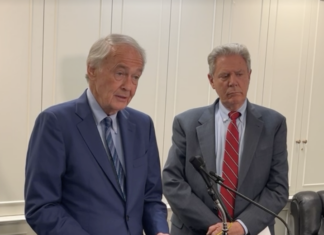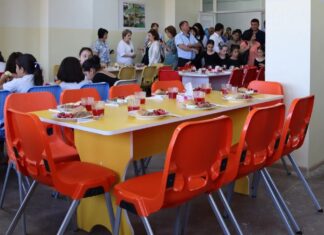Mirror-Spectator Special Section
THE CENTENNIAL OF THE ARMENIAN GENOCIDE is here, and the Armenian Mirror-Spectator is covering its various manifestations throughout the year and beyond. It is too soon to say whether this centennial will be as meaningful as, say, the fiftieth anniversary in
1965, which marked a change in mindset and activism among Armenians throughout the world. Nonetheless, the centennial certainly provides an opportunity for further reflection about the Genocide and its aftermath. The Mirror, continuing its tradition of special supplements on major anniversaries of the Genocide, herein pre- sents a compendium of articles on a variety of related topics.
This year’s supplement begins with the unique proclamation of sainthood by the Church of Armenia of the Armenians killed during the genocide. Mirror- Spectator editor Alin K. Gregorian writes about the meaning of the centennial. Senior Mirror columnist Edmond Y. Azadian looks at the international historical and political context of the Armenian Genocide and the ensuing century of Turkish denial. Political scientist Ronald Suny, in an excerpt from his new book on the genocide, examines the causes of the genocide and the creation of a denialist narrative.
Author and graduate student Ümit Kurt, a native of Aintab, exposes Turkey’s mendacious policies connected to its restrictive definition of national identity, which only now is being seriously challenged.
New York writer Peter Sourian, for many years a professor at Bard College, pre- sents a true life anecdote about a Turkish student’s encounter with Western edu- cation. Armenian ambassador Arman J. Kirakossian, whose father was an impor- tant Soviet Armenian historian, writes about the evolution of the treatment of the Genocide in Armenia over the last century. Muriel Mirak-Weissbach, an author who frequently contributes to the Mirror, shows how an unprecedented wave of cultural activities, media coverage and new publications during this cen- tennial year is educating the German public and leading possibly to political change (see also her article on the new Bundestag resolution in the regular por- tion of the Mirror of this same week).
Matthias Bjørnlund, a Danish archival historian of the Armenian Genocide, demonstrates the importance of terminology in describing an event like the Genocide, and how some Scandinavian and German writers, even prior to Raphael Lemkin’s coinage of the modern term, used words meaning “mur- der/destruction of a people/nation.”
Vartan Matiossian, a historian and educator who is executive director of the Armenian National Education Committee, has an essay about English-language literary approaches to the Armenian Genocide. In an excerpt from his new book, Peter Balakian, a prolific author and professor at Colgate University, specifically
focuses on one Armenian-language writer, the poet Siamanto, who dealt in his work with the violence of the 1909 Adana mas- sacres and shortly thereafter fell victim himself to the violence
of 1915.
Hagop Vartivarian, Armenian-language author and chairman
of the New York chapter of the Tekeyan Cultural Association, pens the biography of Dr. Nazaret Daghavarian, one of the intel- lectuals who fell victim to the Armenian Genocide. Eric Bogosian, well known actor and author, tries to decipher a different type of story in a book excerpt accompanied by a special preface for the Mirror — that
of avenger Soghomon Tehlirian.
Roger W. Smith, a specialist in the comparative study of genocide who is a professor emeritus at the College of William and Mary, thinks in a personal way about the resolution necessary to combat denial and achieve recognition of the Armenian Genocide. Ruth Thomasian, social historian and founder of Project SAVE Armenian Photograph Archives, provides two photographs accompanied by the moving personal stories of two Armenian Genocide survivors.
Finally, in one more essay devoted to the story of individuals which draws out broader lessons, Boston Globe reporter Stephen Kurkjian gives his family histo- ry as a testament to the survival of the Armenian people.
The Mirror is fortunate in this issue to be able to showcase the works of sev- eral artists devoted to the theme of genocide. A graduate of the School of the Museum of Fine Arts in Boston and Tufts University, Hope Metcalf Ricciardi teaches and directs art programs in addition to working in her studio. She is rep- resented by Galatea Fine Art of Boston. Adrienne Der Marderosian of Belmont, Mass., received her bachelor’s degree from Tufts University and also studied at the School of the Museum of Fine Arts in Boston. She has exhibited her work in academic venues and has pieces in museums like the Danforth Museum in Massachusetts and the Hammond Museum in New York. Zhirayr Agavelyan, a graduate of the Leningrad Institute of Culture’s Department of Cinematography, worked for many years in Yerevan as a director at the H1 television station and directed many films. Many of his photo collage creations have been on exhibit in Boston and Yerevan, including recently at Yerevan’s Tekeyan Cultural Association Center, in a showing dedicated to the centennial of the Armenian Genocide. His images do not bear any names because he does not wish to influence the inter- pretation of viewers.
This special supplement has been made possible by a donation from Mr. and Mrs. Nazar and Artemis Nazarian, whose continued support of the Armenian Mirror-Spectator over the years is greatly appreciated.
–Aram Arkun








